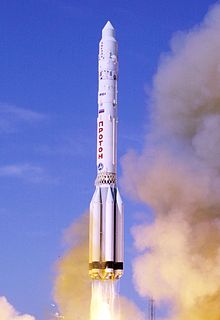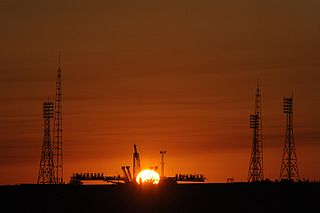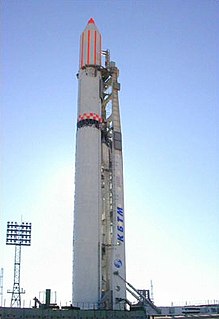Venera 2MV-1 No.2, also known as Sputnik 20 in the Western world, was a Soviet spacecraft, which was launched in 1962 as part of the Venera programme. Due to a problem with its upper stage it failed to leave low Earth orbit, and reentered the atmosphere a few days later. It was the second of two Venera 2MV-1 spacecraft, both of which failed to leave Earth orbit. The previous mission, Venera 2MV-1 No.1, was launched several days earlier.
Kosmos 27, also known as Zond 3MV-1 No.3 was a space mission intended as a Venus impact probe. The spacecraft was launched by a Molniya 8K78 carrier rocket from Baikonur. The Blok L stage and probe reached Earth orbit successfully, but the attitude control system failed to operate.

Proton is an expendable launch system used for both commercial and Russian government space launches. The first Proton rocket was launched in 1965. Modern versions of the launch system are still in use as of 2022, making it one of the most successful heavy boosters in the history of spaceflight. The components of all Protons are manufactured at the Khrunichev State Research and Production Space Center factory in Moscow and Chemical Automatics Design Bureau in Voronezh, then transported to the Baikonur Cosmodrome, where they are assembled at Site 91 to form the launch vehicle. Following payload integration, the rocket is then brought to the launch pad horizontally by rail, and raised into vertical position for launch.

The Baikonur Cosmodrome is a spaceport in an area of southern Kazakhstan leased to Russia. The Cosmodrome is the world's first spaceport for orbital and human launches and the largest operational space launch facility. All crewed Russian spaceflights are launched from Baikonur.

Salyut 2 (OPS-1) was a Soviet space station which was launched in 1973 as part of the Salyut programme. It was the first Almaz military space station to fly. Within two weeks of its launch, the station had lost attitude control and depressurized, leaving it unusable. Its orbit decayed and it re-entered the atmosphere on 28 May 1973, without any crews having visited it.

Salyut 5, also known as OPS-3, was a Soviet space station. Launched in 1976 as part of the Salyut programme, it was the third and last Almaz space station to be launched for the Soviet military. Two Soyuz missions visited the station, each manned by two cosmonauts. A third Soyuz mission attempted to visit the station, but failed to dock, whilst a fourth mission was planned but never launched.
Mars 2M No.522, also known as Mars M-69 No.522 and sometimes identified by NASA as Mars 1969B, was a Soviet spacecraft which was lost in a launch failure in 1969. It consisted of an orbiter. The spacecraft was intended to image the surface of Mars using three cameras, with images being encoded for transmission back to Earth as television signals. It also carried a radiometer, a series of spectrometers, and an instrument to detect water vapour in the atmosphere of Mars. It was one of two Mars 2M spacecraft, along with Mars 2M No.521, which was launched in 1969 as part of the Mars program. Neither launch was successful.

The Zenit-2 is a Ukrainian, previously Soviet, expendable carrier rocket. First flown in 1985, it has been launched 37 times, with 6 failures. It is a member of the Zenit family of rockets and was designed by the Yuzhmash.

Soyuz 7K-L1 No.5L, sometimes identified by NASA as Zond 1967B, was a Soviet spacecraft which was launched in 1967 as part of the Zond programme. It was a 5,390-kilogram (11,880 lb) Soyuz 7K-L1 spacecraft, the second of nine to be launched. It was intended to perform a circumlunar flyby of the Moon before returning to the Earth for landing, but failed to achieve Earth orbit.

Soyuz 7K-L1 No.4L, sometimes identified by NASA as Zond 1967A, was a Soviet spacecraft which was launched in 1967 as part of the Zond programme. It was a 5,390-kilogram (11,880 lb) Soyuz 7K-L1 spacecraft, the first of nine to be launched. Although it was intended to perform a circumlunar flyby of the Moon before returning to the Earth for landing, it failed to achieve Earth orbit.

Gagarin's Start, also known as Baikonur Site 1 or Site 1/5 is a launch site at Baikonur Cosmodrome in Kazakhstan that was used for the Soviet space program and is now managed by Roscosmos.

Site 200 at the Baikonur Cosmodrome is a launch site used by Proton rockets. It consists of two launch pads, areas 39 and 40. Area 39 is currently used for Proton-M launches, including commercial flights conducted by International Launch Services. Area 40 is currently inactive, as it was slated to be rebuilt as a launch site for the Angara rocket. Although the project was relocated to Site 250, Area 40 was not put back into service.

Site 45 at the Baikonur Cosmodrome is a launch site used by Zenit rockets. It consists of two pads, one of which is still in use. It has been the launch site for all Soviet and Russian government Zenit launches, along with a commercial launch conducted for Globalstar in 1998, and continuing commercial launches under the Land Launch programme. The main pad at the site is area 45/1, which was completed in 1983 following five years of construction. A second pad, area 45/2, was completed in 1990, but was destroyed by a launch failure in the same year.
Site 133, also known as Raduga, is a launch complex at the Plesetsk Cosmodrome in Russia. It is used by Rockot, and previously Kosmos carrier rockets. It consists of a single pad, originally designated 133/1, and later 133/3.
Site 16, also known as SK-2, is a launch complex at the Plesetsk Cosmodrome in Russia. It consists of a single pad, Site 16/2, and has been used by R-7 derived rockets since 1960.

Site 43, also known as SK-3 and SK-4, is a launch complex at the Plesetsk Cosmodrome in Russia. It consists of a two pads, Sites 43/3 and 43/4, and has been used by R-7 derived rockets since the early 1960s.
Site 250 at the Baikonur Cosmodrome, also known as UKSS and Bayterek, is a test facility and launch site which was used by the Energia rocket during the 1980s. The site consists of a single launch pad, which doubled as a test stand, and is supported by an engineering area and a propellant storage facility. As of 2011 the complex was planned to be rebuilt as the Bayterek Launch Complex, which would be used by the Angara rocket from 2015; however development is yet to begin.
Site 110 at the Baikonur Cosmodrome is a launch facility which was used by the N1 rocket during the late 1960s and early 1970s, and by the Energia rocket during the 1980s.
The RD-0214 (GRAU Index: 8D811) is a rocket vernier engine burning N2O4 and UDMH in a gas generator cycle. It has four nozzles that can each gimbal 45 in plane to provide TVC to the RD-0212 propulsion module of Proton third stage. It is a revised version of the RD-0207.

The RD-0210 (GRAU Index: 8D411K) is also known as the RD-465. It and its twin, the RD-0211, are rocket engines burning N2O4 and UDMH in an oxidizer rich staged combustion cycle. They have single nozzle, possess TVC and are the latest evolution in the RD-0203/4 lineage. They are the engines used on the Proton second stage. The RD-0213 is a fixed nozzle variation that is used on the RD-0212 module of the Proton third stage.










